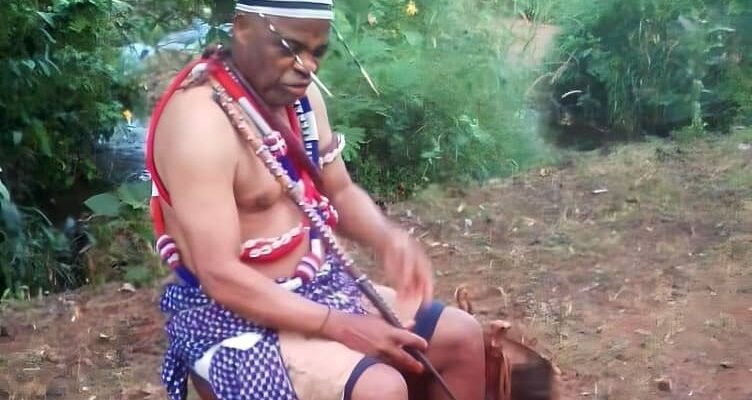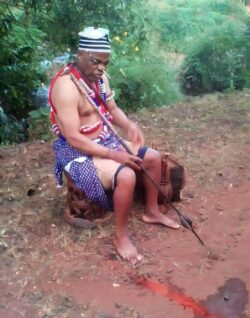Nso’ Traditional Religion and Climate Forecast: A Photo Analysis

By Banla Noela Kinyuy
Climate change continues to plague the world leading to varied methods of predicting and adapting to this global challenge. Faced with this reality, the Nso’ Fondom (the Kingdom of the Nso people in Cameroon) employ the services of the custodians of their traditional religion, who used to play, and continue to play, a critical role in climate monitoring and forecast. Some of their ritual activities have been preserved in photographs for posterity purpose. Through photographs the role of traditional religion in climate forecast in Nso’ could be revisited as photographs assist in our understanding of events by capturing the scene. In this blog post, I discuss one photograph of importance, of the Fon of Nkar in Nso’ who was involved in climate forecast. The Fon is the traditional ruler, the head of the traditional government and chief religious priest in charge of keeping the ancestors happy and perform annual rituals, which among others have an ecological purpose, as demonstrated on the photograph here.

The Fon of Nkar reading messages of the gods through the red line during a ritual at Shuukindzev Shrine in Nso. Image by Delavmfu 2020.
The photograph represents the Fon of Nkar beside a red line carefully observing it as a way of communicating with the gods. In Nso’ traditional beliefs, the soil is dug and mixed with camwood, palm wine and other traditional substances to seek for answers from the gods through whom the future is predicted. The Fons attention is tilted towards the line which indicates he was reading the message of the gods (Interview with Fokala, 2023). Besides the Fon is a calabash identified in the picture with (A). It contains palm wine from which libations were poured, and a raffia bag containing other items used to perform ritual. Oral history holds that after this particular rituals exercise in 2020, rains were forecasted to be very destructive and the Nso’ community was encouraged to stay home when heavy rains were expected (interview with Rannyuy). The photograph signifies the Nso’ traditional religious practices and offers a rich representation of traditional belief system in Nso’. As Micheala Peach notes, “a photograph is worth more than a thousand words” (Peach, 2004).
The photograph calls to memory how traditional religious practices permeate every aspect of life in Nso’. Traditional religion in many ways was, and still is, used as a medium through which they predict certain happenings and solve their day-to-day problems. By way of explicating the concept of traditional religions or traditional beliefs and practices, they are a set of highly diverse beliefs that include various ethnic religions. Nso’ traditional religion in this context, deals with beliefs and practices of the Nso’ people of the Bamenda Grasslands of Cameroon exhibited through their way of worship, consultation of the gods by priests, rituals, symbols, cosmology, arts, practices and their interaction with the environment. Nso’ traditional religion au fond believes in the existence of God considered as a Supreme Being and referred to as Nyuymbom which means, “God of creation”. Besides, Nyuymbom was assisted in His duties to the people by other divinities with specific assignments. These divinities were named by their assigned duties. For instance, there was “god of the rain”, and “god of the sun” who connected directly to the ancestors of the land and helped channeled the requests of the people to Nyuymbom.
In connecting with the gods, the Fons (kings) of Nso’ and lineage heads act as chief priests, and serve as a veritable link between the living and ancestors. They offer sacrifices to the gods to solicit for abundant harvest, rain fall, high fecundity, and to predict the future in regards to ecology or any other intention. Divinities (a nyuy) are appeased to protect the country and set against waywardness and destructions in the form of rainstorms, landslides, rainbows, thunder, lightning and harsh and destructive sun shine. Rituals take place in shrines at the level of family compounds, lineage heads compounds or areas controlled by the Fons in some strategic locations. Some equally took place at bridges where the spirits of the ancestors were invoked with palm wine and camwood by the priests to prevent the entry of malicious persons, in a formula repeated at other points of entry or markets (Chilver 1990: 226-247). Animals, palm wine, palm oil, salt, camwood and other items were offered to the gods (Maika 2005: 12).
The photo reveals that, in relating to their environment, traditional religious custodians consult the gods and communicate information from the gods to members of their communities. This information acts as a guide to the people as they believe in the idea that: “the gods reveal to redeem”. Even with the presence of modern/Western mediums of climate forecast, the Nso’ people still depend on traditional religious activities in determining when to plant, harvest, things to avoid, and how to react to situations. The Nwerong institutions also involved in climate forecast is referred to as Taar Nsai (owner of the land), who gives orders which communities follow. Thanks to traditional religion in Nso’, custodians of culture have been able to monitor climate variations and to pre-empt its destructiveness especially during the periods of pest plague, heavy rains, and harsh sunshine as well as seasonal change.
Despite the importance of photography in relaying these historical memories, crucial moments like the various processes of rituals performance were not photographed as some ritual activities like those of the regulatory societies such as Nwerong took place at nights. It is generally believed that some of the activities cannot be photographed and that even if someone tried to capture it the image will appear blank. My research therefore complemented ‘what the eyes see’ with oral versions and written sources, to build up a more comprehensive account of developments associated with the pictures available to exploit.
Banla Noela Kinyuy is a PhD Candidate at The University of Bamenda, Cameroon. She is an early career researcher specializing in visual history. She is currently researching on “Photo-narratives of patterns of power and socio-economic life among the Nso’, 1907-2022” for her PhD thesis. In July 29-31 2023, she participated in the “African ecologies” writing and mentorship workshop hosted at the British Institute in East Africa in collaboration with the Leeds University Centre for African Studies. This blog post is an extraction from the paper presented at the workshop.
